(Blogger’s note: Before diving into today’s [rather lengthy] post, my apologies for the scarcity of new content of late. Family issues and the recent holiday weekend placed some demands on my time—not to mention a couple of job interviews (crossed fingers!). Anyway, now that we’ve cleared the decks, let’s review a new way of looking at the cards.)
One of the perennial challenges that confront Tarot scholars and students alike is the assignment of a so-called “court” card to represent a querent—or even ourselves—in a reading. Whole books have been devoted solely to the subject, and even advanced students can find the task daunting because of the way the human psyche can evolve and mutate as it passes from childhood and adolescence into adulthood and old age. A person with a watery, dreamy “Cups” nature in youth, for example, can eventually be transformed into an extroverted, goal-driven “Sword” personality later in adulthood. Your humble blogger is living proof of this, and in this regard he is not in anywise unique.
For many years, assigning a “significator” card was traditionally effected according to the querent’s physical characteristics, with Wands and Swords typically standing for light-skinned, lighter-haired individuals, Cups for darker-haired persons, and Pentacles for darker-skinned persons. This assignment metric, while perhaps justifiable at one time in the history of human consciousness, is somewhat archaic in our increasingly multiethnic and multicultural world—not to mention its tendency to traffic in ethnic stereotyping.
Another method for divining a querent’s “identity” within the deck—and one that is arguably the most popular today—has been to use the querent’s astrological birth sign as a correlative, to “match up” the querent with the court card that is said to be “governed” by that particular sign. It’s not precise, but it is workable in many cases, though a willingness to adapt as needed is advised. The court card governed by the sign of Cancer, for instance, is the Queen of Cups—but what if the querent is a Cancer male? The Queen could stand for certain, more passive, i.e., “feminine” elements of the querent’s psyche—or, if he should seem more gregarious, i.e., masculine, in his demeanor, another “water-sign” card such as the King of Cups (governed by Pisces) or another “Cancer” card such as “The Chariot” from the Major Arcana could be substituted. Tarot is nothing if not flexible in this regard, so don’t be afraid to think creatively.
There is another, more recent method to assign court cards to others, and to ourselves, that draws upon principles of modern depth psychology: The Myers-Briggs Type Indicator, the behavioral aptitude test/questionnaire most often used by employers to determine the suitability of their employees to certain kinds of work but which we can also use to clarify our career objectives, or to ascertain our compatibility with a potential partner in business or romance. (For those who have never taken the test and would like to explore its findings in greater depth, there are many free versions available online; one can be found here.)
In brief, the MBTI attempts to codify in shorthand the theory advanced by the Swiss psychoanalyst C.G. Jung in his landmark survey Psychological Types, published in 1923. Jung’s theory of personality posited that the human psyche is governed by four primary cognitive functions (thinking, feeling, sensation, and intuition), each one of which manifests itself in one of two orientations, either extra- or introverted, yielding a total of eight “dominant” functions. Elaborating upon Jung’s work in subsequent decades, Katharine Cook Briggs and her daughter, Isabel Myers, refined the theory by adding two secondary personality types, “judging” and “perception”, which also take extra- or introverted forms. These two extra elements, in combination with the others previously mentioned, yield a possible of 16 personality “types,” each of which is represented by a four-letter abbreviation.
Viewed as binaries, we can visualize the personality functions as:
Extraversion (E) < — > Introversion (I)
Intuition (N) < — > Sensation (S)
Thinking (T) < — > Feeling (F)
Judging (J) < — > Perceiving (P)
Before proceeding further, astute Tarot students may already be noting the parallels between Jung’s four primary functions—thinking, feeling, intuition and sensation—to the the four suits, to wit:
Wands: Intuition.
Cups: Feeling.
Swords: Thinking.
Pentacles: Sensation.
Further, the 16 total personality types defined by the Myers-Briggs method correspond exactly to the 16 court cards of the Tarot. If we pause to reflect on what we have already learned about the court cards’ “personality types” based on rank, suit and astrological sign, we can begin to understand where they fit in the MBTI taxonomy. For instance, Kings and Princes, conquerors and rulers by nature, can generally be considered “extraverts”; Queens and Princesses, more concerned with domestic and internal affairs, can be thought of as “introverts.” Elder Kings and Queens are generally governed by the “judging” function, while youthful Princes and Princesses are more likely to fall under the sway the “perceiving” function.
So, as an example, referring to the binaries above, we can already discern that the King of Wands, governed by fiery Aires, is an extrovert (E), intuitive (N), thinking (T) and judging (J). Hence “ENTJ” is the King of Wands’ Myers-Briggs personality type.
Running down the court cards, we can break down their MBTI “scores”, and their personality types, as follows:
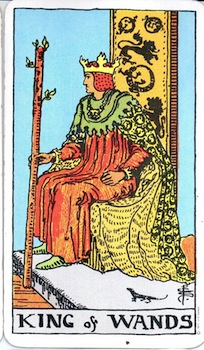 King of Wands: ENTJ. This personality is fiery and forceful in its leadership style, and a creative thinker and problem-solver in the workplace. A bit of a visionary, he prefers pursuing long-range, big-picture goals than in aiming for short-term goals, even if the latter are more easily achieved. This type is a voracious reader who is in constant search of fresh perspective and knowledge of new philosophies and technologies. Ill-dignified, he can be a bit of a perfectionist, rash in his assessment of others, and possibly prone to “burn bridges” in his dealings with others. Likely careers: Attorney or judge, corporate officer or executive, business administrator, university professor. Most compatible types: INFP (Princess of Cups), INTP (Princess of Wands).*
King of Wands: ENTJ. This personality is fiery and forceful in its leadership style, and a creative thinker and problem-solver in the workplace. A bit of a visionary, he prefers pursuing long-range, big-picture goals than in aiming for short-term goals, even if the latter are more easily achieved. This type is a voracious reader who is in constant search of fresh perspective and knowledge of new philosophies and technologies. Ill-dignified, he can be a bit of a perfectionist, rash in his assessment of others, and possibly prone to “burn bridges” in his dealings with others. Likely careers: Attorney or judge, corporate officer or executive, business administrator, university professor. Most compatible types: INFP (Princess of Cups), INTP (Princess of Wands).*
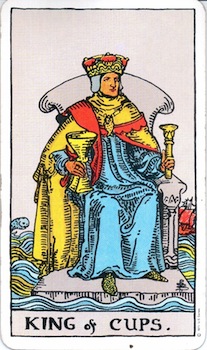 King of Cups: ENFJ. This personality type is highly sensitive to the needs of other people, and sees it as its mission in life to help others achieve their fullest potential. Rather than “leading up front,” this type prefers to work “behind the scenes,” deflecting credit due itself onto others. As such, it inspires intense feeling of loyalty—or, perhaps, jealousy—from those whose lives it touches, and the type may even be viewed as a guru or a Svengali, depending on his social setting. Ill dignified, this type can be preachy and dogmatic, inflexible, occasionally needy, and at worst, may engage in obsessive-compulsive behavior. Likely careers: Psychologist, social worker, clergy, teacher, diplomat. Most compatible types: INFP (Princess of Cups), INTP (Princess of Wands).
King of Cups: ENFJ. This personality type is highly sensitive to the needs of other people, and sees it as its mission in life to help others achieve their fullest potential. Rather than “leading up front,” this type prefers to work “behind the scenes,” deflecting credit due itself onto others. As such, it inspires intense feeling of loyalty—or, perhaps, jealousy—from those whose lives it touches, and the type may even be viewed as a guru or a Svengali, depending on his social setting. Ill dignified, this type can be preachy and dogmatic, inflexible, occasionally needy, and at worst, may engage in obsessive-compulsive behavior. Likely careers: Psychologist, social worker, clergy, teacher, diplomat. Most compatible types: INFP (Princess of Cups), INTP (Princess of Wands).
 King of Swords: ESTJ. Practical and pragmatic, this personality type eschews idealism for matter-of-factness in thinking and problem-solving. Detailed analysis is for others—in a social setting, this type is a “doer,” decisive in his actions and highly results-oriented. More interested in justice than in fairness, this type adheres to a code of standards guided more by efficiency more than equity, and he expects the same of others. Ill dignified, he can be amoral, insincere and ruthless in his dealings with others, and thus give the impression of being “two-faced” and unreliable. Likely careers: Police, judge, military, sciences, administration, sales. Most compatible types: ISFP (Princess of Pentacles), ISTP (Princess of Swords).
King of Swords: ESTJ. Practical and pragmatic, this personality type eschews idealism for matter-of-factness in thinking and problem-solving. Detailed analysis is for others—in a social setting, this type is a “doer,” decisive in his actions and highly results-oriented. More interested in justice than in fairness, this type adheres to a code of standards guided more by efficiency more than equity, and he expects the same of others. Ill dignified, he can be amoral, insincere and ruthless in his dealings with others, and thus give the impression of being “two-faced” and unreliable. Likely careers: Police, judge, military, sciences, administration, sales. Most compatible types: ISFP (Princess of Pentacles), ISTP (Princess of Swords).
 King of Pentacles: ESFJ. This personality type is sociable to a fault, seeking the company of others in work and at leisure. This type shines in large groups, and enjoys being the center of attention while not overlooking the contributions of others; he believes in “strength in numbers” and is effusive in his praise for others. A loyal friend and an understanding co-worker, this type seeks consensus and cooperation; in return, it seeks acknowledgment for its accomplishments as it gives in kind unto others, and ill dignified, this type can be boorish, coarse and vulgar if it feels its generosities are beings taken for granted or ignored. Likely careers: Medicine, counseling, child care, teaching, cooking. Most compatible types: ISFP (Princess of Pentacles), ISTP (Princess of Swords).
King of Pentacles: ESFJ. This personality type is sociable to a fault, seeking the company of others in work and at leisure. This type shines in large groups, and enjoys being the center of attention while not overlooking the contributions of others; he believes in “strength in numbers” and is effusive in his praise for others. A loyal friend and an understanding co-worker, this type seeks consensus and cooperation; in return, it seeks acknowledgment for its accomplishments as it gives in kind unto others, and ill dignified, this type can be boorish, coarse and vulgar if it feels its generosities are beings taken for granted or ignored. Likely careers: Medicine, counseling, child care, teaching, cooking. Most compatible types: ISFP (Princess of Pentacles), ISTP (Princess of Swords).
 Queen of Wands: INTJ. Analytical and self-motivated, this personality type shares many of the same characteristics as its ENTJ (King of Wands) counterpart, though it internalizes many of the traits its counterpart projects outward. This type holds itself to the highest ethical and professional standards, and is dogged in determination once it has begun a project or commenced with a relationship. LIke the ENTJ, this type can tend toward perfectionism, and ill dignified, it can engage in self-destructive behavior if it fails to live up to its own expectations; it can also be conniving and scheming, and perceived to have ulterior motives in its dealings with others. Likely careers: Medicine, engineering, computer science, attorney or judge. Most compatible types: ENFP (Prince of Cups), ENTP (Prince of Wands).
Queen of Wands: INTJ. Analytical and self-motivated, this personality type shares many of the same characteristics as its ENTJ (King of Wands) counterpart, though it internalizes many of the traits its counterpart projects outward. This type holds itself to the highest ethical and professional standards, and is dogged in determination once it has begun a project or commenced with a relationship. LIke the ENTJ, this type can tend toward perfectionism, and ill dignified, it can engage in self-destructive behavior if it fails to live up to its own expectations; it can also be conniving and scheming, and perceived to have ulterior motives in its dealings with others. Likely careers: Medicine, engineering, computer science, attorney or judge. Most compatible types: ENFP (Prince of Cups), ENTP (Prince of Wands).
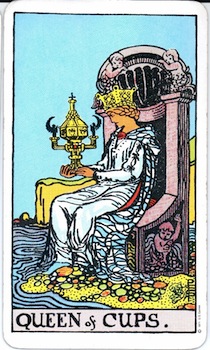 Queen of Cups: INFJ. This personality type is extremely sensitive to the interdependence and interconnectedness of all things—material, ethical and spiritual. An eager student, this type is intensely curious to know the inner or “hidden” origins if the world, and as such is likely to be an avid reader of philosophical, religious or so-called “metaphysical” works. While this personality type devotes itself to the improvement or enlightenment of others, it also requires time spent alone in solitary introspection, contemplating the mysteries of life and its own role in it. Ill dignified, this type can be withdrawn and moody, irrational and even delusional—there’s a thin line between a spiritual healer and someone with a “Messiah complex,” and this type may thread the needle more than once during its life. Likely careers: Music and arts, alternative medicine/health care, clergy/spiritualism, medicine. Most compatible types: ENFP (Prince of Cups), ENTP (Prince of Wands).
Queen of Cups: INFJ. This personality type is extremely sensitive to the interdependence and interconnectedness of all things—material, ethical and spiritual. An eager student, this type is intensely curious to know the inner or “hidden” origins if the world, and as such is likely to be an avid reader of philosophical, religious or so-called “metaphysical” works. While this personality type devotes itself to the improvement or enlightenment of others, it also requires time spent alone in solitary introspection, contemplating the mysteries of life and its own role in it. Ill dignified, this type can be withdrawn and moody, irrational and even delusional—there’s a thin line between a spiritual healer and someone with a “Messiah complex,” and this type may thread the needle more than once during its life. Likely careers: Music and arts, alternative medicine/health care, clergy/spiritualism, medicine. Most compatible types: ENFP (Prince of Cups), ENTP (Prince of Wands).
 Queen of Swords: ISTJ. Like its ESTJ counterpart (the King), this personality type is pragmatic, practical, results-oriented, and a natural-born organizer and “duty fulfiller”. It takes great pride in bringing about order from chaos and harmony from disunion, and because of this, it demands loyalty both in the workplace and at home. This type can be stubborn, but often in the pursuit of a greater good, and because it emphasizes comity above all else, it will go to great lengths to avoid conflict with others unless provoked. Ill dignified, this type can seem unethical and amoral in its dealings, and can sometimes be overbearing and even threatening unless it “gets its way” in its relationships with others. Likely careers: Attorney/judge, military/police, business administration, consulting/human resources. Most compatible types: ESFP (Prince of Pentacles), ESTP (Prince of Swords).
Queen of Swords: ISTJ. Like its ESTJ counterpart (the King), this personality type is pragmatic, practical, results-oriented, and a natural-born organizer and “duty fulfiller”. It takes great pride in bringing about order from chaos and harmony from disunion, and because of this, it demands loyalty both in the workplace and at home. This type can be stubborn, but often in the pursuit of a greater good, and because it emphasizes comity above all else, it will go to great lengths to avoid conflict with others unless provoked. Ill dignified, this type can seem unethical and amoral in its dealings, and can sometimes be overbearing and even threatening unless it “gets its way” in its relationships with others. Likely careers: Attorney/judge, military/police, business administration, consulting/human resources. Most compatible types: ESFP (Prince of Pentacles), ESTP (Prince of Swords).
 Queen of Pentacles: ISFJ. Caring and empathetic, this personality most closely resembles an “earth mother” type—a loving caregiver and nurturer to all, which sees itself as a quiet catalyst to help others achieve their fullest life potential. This type has a deep and abiding respect for traditional structures in family, friendships and romance, and as such is slow to adapt to sudden changes in these structures, preferring the predictable “passing of the seasons” to which it feels itself so highly attuned. This type is very emotional, but as an introvert it will not express emotion readily‚ unless, perhaps, it is in need of a cathartic release. Ill dignified, this type can be moody and sullen, may be prone to depression and even to abuses of alcohol and drugs. Likely careers: Nursing and child care, social work/ counseling, cooking and shopkeeping. Most compatible types: ESFP (Prince of Pentacles), ESTP (Prince of Swords).
Queen of Pentacles: ISFJ. Caring and empathetic, this personality most closely resembles an “earth mother” type—a loving caregiver and nurturer to all, which sees itself as a quiet catalyst to help others achieve their fullest life potential. This type has a deep and abiding respect for traditional structures in family, friendships and romance, and as such is slow to adapt to sudden changes in these structures, preferring the predictable “passing of the seasons” to which it feels itself so highly attuned. This type is very emotional, but as an introvert it will not express emotion readily‚ unless, perhaps, it is in need of a cathartic release. Ill dignified, this type can be moody and sullen, may be prone to depression and even to abuses of alcohol and drugs. Likely careers: Nursing and child care, social work/ counseling, cooking and shopkeeping. Most compatible types: ESFP (Prince of Pentacles), ESTP (Prince of Swords).
 Prince of Wands: ENTP. A true visionary, this personality type combines a razor-sharp intellect with acute intuitive skills, and is a “quick study” at virtually any subject it attempts to undertake. A dynamic personality and a skilled communicator, it is quick to contribute its opinions in the workplace, and to spin a humorous yarn at home. This personality type is often known as an “idea person” who can sometimes lose sight of the “real-world” implications of its ideas in a fog of abstraction, and who can grow bored at times if not consistently challenged. Ill dignified, they can come across as argumentative, self-righteous, one-dimensional and divorced from reality. Likely careers: Attorney, entrepreneur/executive, sales and marketing, theater/film/TV. Most compatible types: INFJ (Queen of Cups), INTJ (Queen of Wands).
Prince of Wands: ENTP. A true visionary, this personality type combines a razor-sharp intellect with acute intuitive skills, and is a “quick study” at virtually any subject it attempts to undertake. A dynamic personality and a skilled communicator, it is quick to contribute its opinions in the workplace, and to spin a humorous yarn at home. This personality type is often known as an “idea person” who can sometimes lose sight of the “real-world” implications of its ideas in a fog of abstraction, and who can grow bored at times if not consistently challenged. Ill dignified, they can come across as argumentative, self-righteous, one-dimensional and divorced from reality. Likely careers: Attorney, entrepreneur/executive, sales and marketing, theater/film/TV. Most compatible types: INFJ (Queen of Cups), INTJ (Queen of Wands).
 Prince of Cups: ENFP. An “inspiring” personality, this type has a knack for winning the hearts and minds of others with its keen intuition and an intellect with a seemingly limitless knowledge of virtually every subject under the sun. Almost always ready to share some kernel of insight with others, this type is adept at encouraging others to “open up” in kind, and is often looked up to as a “role model.” This type tends to bore easily in the presence of less inquiring minds, and it can appear restless, unpredictable and even flighty to others. This type has a deep-seated need to be liked, and ill dignified, he can be overly needy, narcissistic and manipulative. Likely careers: Politics, journalism/writing, arts and music. Most compatible types: INFJ (Queen of Cups), INTJ (Queen of Wands).
Prince of Cups: ENFP. An “inspiring” personality, this type has a knack for winning the hearts and minds of others with its keen intuition and an intellect with a seemingly limitless knowledge of virtually every subject under the sun. Almost always ready to share some kernel of insight with others, this type is adept at encouraging others to “open up” in kind, and is often looked up to as a “role model.” This type tends to bore easily in the presence of less inquiring minds, and it can appear restless, unpredictable and even flighty to others. This type has a deep-seated need to be liked, and ill dignified, he can be overly needy, narcissistic and manipulative. Likely careers: Politics, journalism/writing, arts and music. Most compatible types: INFJ (Queen of Cups), INTJ (Queen of Wands).
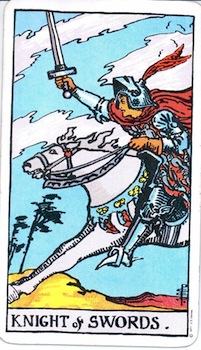 Prince of Swords: ESTP. Animated by action and a natural risk-taker, this personality type is a “doer,” a confident and energetic challenge-seeker who readily wins the admiration of others by its willingness to ”take the lead” in any initiative. A gifted intellect, this type is possessed of a near-bottomless ambition, and on the surface at least is an excellent strategist. This type sees himself as a bit of a crusader, and his innate inclination to “action” before “analysis,” however well-intentioned, can lead to poor decision-making, and ill dignified he can be seen as rash, impetuous, and prone to unforced errors; gambling debts and money problems are not unheard of with this type. Likely careers: Athletics, police/military, sales and marketing, emergency services (e.e., firefighting). Most compatible types: ISFJ (Queen of Pentacles), ISTJ (Queen of Swords)
Prince of Swords: ESTP. Animated by action and a natural risk-taker, this personality type is a “doer,” a confident and energetic challenge-seeker who readily wins the admiration of others by its willingness to ”take the lead” in any initiative. A gifted intellect, this type is possessed of a near-bottomless ambition, and on the surface at least is an excellent strategist. This type sees himself as a bit of a crusader, and his innate inclination to “action” before “analysis,” however well-intentioned, can lead to poor decision-making, and ill dignified he can be seen as rash, impetuous, and prone to unforced errors; gambling debts and money problems are not unheard of with this type. Likely careers: Athletics, police/military, sales and marketing, emergency services (e.e., firefighting). Most compatible types: ISFJ (Queen of Pentacles), ISTJ (Queen of Swords)
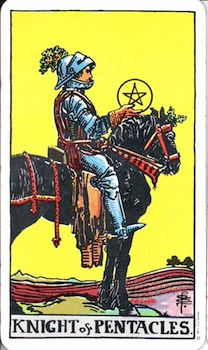 Prince of Pentacles: ESFP. An aesthete and a sensualist, this personality type loves “the good life” and delights in sharing it with others. A natural “entertainer” of sorts, this type is gregarious and outgoing in public, a “hale fellow well met” who will do anything to keep his friends happy. This type, however, is also very much in touch with the feelings of others, and being in the presence of the unhappiness of others amidst his wealth and plenty makes him feel insecure, insignificant and even ignored—and ill dignified, he can be seen as impulsive, unpredictable, and prone to “Citizen Kane”-style outbursts of anger and indignation. Likely careers: Acting and theater, creative arts and design,arts and music. Most compatible types: ISFJ (Queen of Pentacles), ISTJ (Queen of Swords).
Prince of Pentacles: ESFP. An aesthete and a sensualist, this personality type loves “the good life” and delights in sharing it with others. A natural “entertainer” of sorts, this type is gregarious and outgoing in public, a “hale fellow well met” who will do anything to keep his friends happy. This type, however, is also very much in touch with the feelings of others, and being in the presence of the unhappiness of others amidst his wealth and plenty makes him feel insecure, insignificant and even ignored—and ill dignified, he can be seen as impulsive, unpredictable, and prone to “Citizen Kane”-style outbursts of anger and indignation. Likely careers: Acting and theater, creative arts and design,arts and music. Most compatible types: ISFJ (Queen of Pentacles), ISTJ (Queen of Swords).
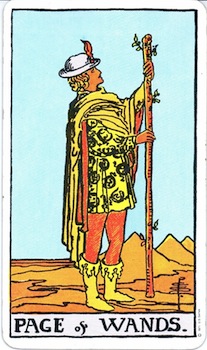 Princess of Wands: INTP. A “thinker” par excellence, this personality type is a supremely gifted intellect that tends to “look within,” engaging its powers of analysis to gain new insights into its world and of others around it. A natural introvert, this type can seem withdrawn and shy, but can often be brought “out of its shell” when the subject of conversation aligns with its interests. Ill dignified, this type can be seen as antisocial, misogynistic and relentlessly self-centered, though in reality—as with many of civilization’s most brilliant thinkers—some people are just naturally better suited to spend their lives in the laboratory rather than in the public eye. Likely careers: Physics and astronomy, mathematics and engineering, computer science, forensic research. Most compatible types: ENFJ (King of Cups), ENTJ (King of Wands).
Princess of Wands: INTP. A “thinker” par excellence, this personality type is a supremely gifted intellect that tends to “look within,” engaging its powers of analysis to gain new insights into its world and of others around it. A natural introvert, this type can seem withdrawn and shy, but can often be brought “out of its shell” when the subject of conversation aligns with its interests. Ill dignified, this type can be seen as antisocial, misogynistic and relentlessly self-centered, though in reality—as with many of civilization’s most brilliant thinkers—some people are just naturally better suited to spend their lives in the laboratory rather than in the public eye. Likely careers: Physics and astronomy, mathematics and engineering, computer science, forensic research. Most compatible types: ENFJ (King of Cups), ENTJ (King of Wands).
 Princess of Cups: INFP. Much like its “mother” INFJ (Queen of Cups), this personality type is deeply idealistic and devoted to living life in the pursuit of a higher, more noble cause than its own self-enrichment. This type tends to innately see the best in others, and as a rule relies on feeling and intuition rather than on logic when forming associations in public or at work. At best, this personality type can a “miracle worker” that can inspire others to great works; ill dignified, though, it can turn into an irrational “control freak” when it discovers that its loyalty to others was at times misplaced, and it is now in need of an emotional compensating mechanism. Likely careers: Counseling and social work, psychology, clergy, music and writing. Most compatible types: ENFJ (King of Cups), ENTJ (King of Wands).
Princess of Cups: INFP. Much like its “mother” INFJ (Queen of Cups), this personality type is deeply idealistic and devoted to living life in the pursuit of a higher, more noble cause than its own self-enrichment. This type tends to innately see the best in others, and as a rule relies on feeling and intuition rather than on logic when forming associations in public or at work. At best, this personality type can a “miracle worker” that can inspire others to great works; ill dignified, though, it can turn into an irrational “control freak” when it discovers that its loyalty to others was at times misplaced, and it is now in need of an emotional compensating mechanism. Likely careers: Counseling and social work, psychology, clergy, music and writing. Most compatible types: ENFJ (King of Cups), ENTJ (King of Wands).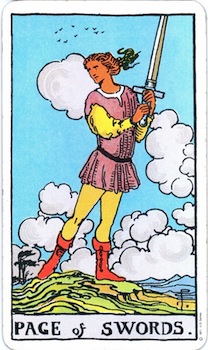 Princess of Swords: ISTP. An inquiring mind with a predilection for observation, this personality type finds itself more interested in watching people rather than interacting with them, and with observing how the world works rather than jumping into it. This personality type is often referred to as a “mechanic” because of its apparent practical, rather than emotional or intellectual, interest in the workings of the world. On the other hand, the “mechanic” impulse can be an emotional compensating mechanism for someone who is (or secretly yearns to be) a daredevil or thrill-seeker in life, and ill dignified, this type can be prone to symptoms of excessive risk-taking: High levels of stress, nervous fits, and unpredictable mood swings. Likely careers: Police and forensics, mechanical trades, pilots or drivers, athletics. Most compatible types: ESFJ (King of Pentacles), ESTJ (King of Swords).
Princess of Swords: ISTP. An inquiring mind with a predilection for observation, this personality type finds itself more interested in watching people rather than interacting with them, and with observing how the world works rather than jumping into it. This personality type is often referred to as a “mechanic” because of its apparent practical, rather than emotional or intellectual, interest in the workings of the world. On the other hand, the “mechanic” impulse can be an emotional compensating mechanism for someone who is (or secretly yearns to be) a daredevil or thrill-seeker in life, and ill dignified, this type can be prone to symptoms of excessive risk-taking: High levels of stress, nervous fits, and unpredictable mood swings. Likely careers: Police and forensics, mechanical trades, pilots or drivers, athletics. Most compatible types: ESFJ (King of Pentacles), ESTJ (King of Swords).
Princess of Pentacles: ISFP. Like its “brother” ESFP (Prince of Pentacles), this personality type is an aesthete par excellence that draws its deepest inspiration from works of art, music, poetry and from the physical stimulation that nature can provide. Deeply emotional yet introspective by nature, they sometimes have difficulty expressing themselves directly to others, instead preferring to communicate via writing or composing than by engaging in conversation. For this reason (among others), they tend to be “free spirits” who don’t respond well to supervision but who need to be given a great deal of “personal space” to maximize their fullest potential. Ill dignified, this type can seem to be self-absorbed, unreliable and even rather dim-witted. Likely careers: Arts and music, industrial design, counseling/psychology, outdoor professions (e.g., farming, forestry). Most compatible types: ESFJ (King of Pentacles), ESTJ (King of Swords).
* For the record, this is also your humble blogger’s current MBTI “type,” though he has used the King of Swords, not Wands, as his Significator for the last ten years. At this stage of his life, perhaps a change is in order.

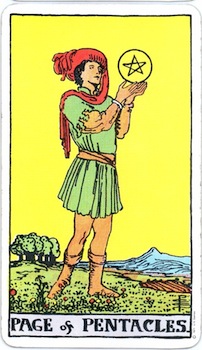
Amazing post! I am a MBTI lover and I just got into tarot readings, so this is very exciting for me! 🙂
I have a few questions though… Did you group the types based on dominant functions? For example: ENFP’s dominant function is extroverted intuition not extroverted feeling, so I thought it would end up in the wands instead of cups. How did you group them? Based on reading all the descriptions?
LikeLiked by 1 person